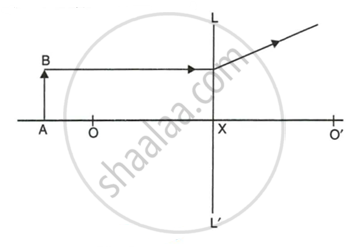Advertisements
Advertisements
Question
An object is 2 m from a lens which forms an erect image one-fourth (exactly) the size of the object. Determine the focal length of the lens. What type of lens is this?
Solution
Given:
Object distance (u) =-2 m
Image distance (v) = ?
Magnification (m) = 0.25 (one-fourth of the size of the image)
Focal length (f) = ?
Magnification (m) =`v/u`
`0.25=v/-2`
v=-0.5m
Putting these values in lens formula, we get:
`1/v-1/u=1/f`
`1/-0.5+1/-2=1/f`
`1/-0.5+1/2=1/f`
`1/f=1/2-1/0.5`
`1/f=1/2-10/5`
`1/f=(-3)/2`
`f=-0.66` m
Negative sign of focal length shows that lens is diverging in nature. Hence, it is a concave lens.
APPEARS IN
RELATED QUESTIONS
If an object is placed 21 cm from a converging lens, the image formed is slightly smaller than the object. If the object is placed 19 cm from the lens, the image formed is slightly larger than object. The approximate focal length of the lens is ______.
How would a pencil look like if you saw it through
a concave lens Is the image real or virtual?
Study the diagram below.

- Name the lens LL’.
- What are the points O and O' called ?
- Complete the diagram to form the image of the object AB.
- State three characteristics of the image.
Where will the image be formed if an object is kept in front of a concave lens at a distance equal to its focal length? Draw a ray diagram to illustrate your answer.
If the image formed by a lens is diminished in size and erect, for all positions of the object, what type of lens is it?
Explain the working of an astronomical telescope using refraction of light.
An object is placed at a distance 24 cm in front of a convex lens of focal length 8 cm.
(i) What is the nature of the image so formed?
(ii) Calculate the distance of the image from the lens.
(iii) Calculate the magnification of the image.
Express power of a concave lens of focal length 50 cm with its sign.
If the power of a lens is -4.0 D, then it means that the lens is a ______.
Distinguish between:
Concave Lens and Convex Lens
